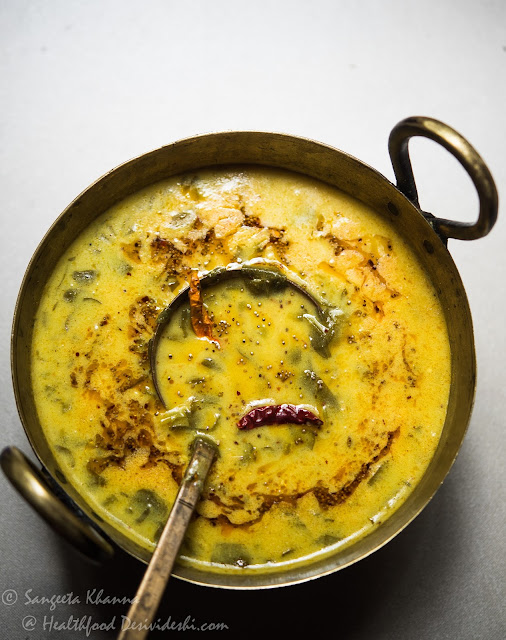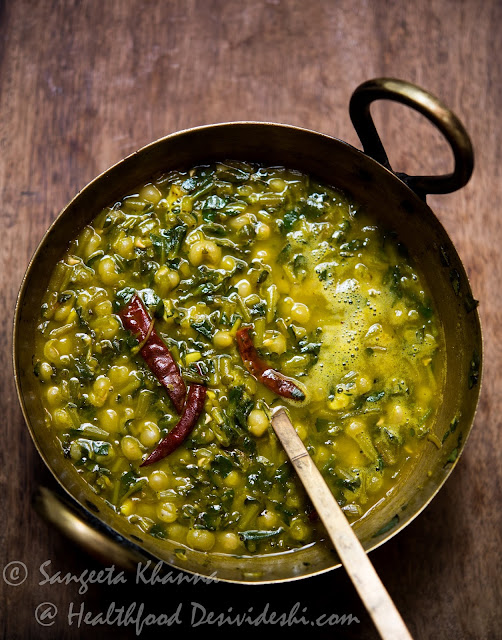purslane or kulfa ka saag | greens of the season | 6 purslane recipes for eating healthy everyday
Purslane is one of those summer leafy green vegetable that is highly undervalued. Let me tell you why Purslane is such a good vegetable to include in your everyday diet. Buy a big bunch of Purslane and use it 3-4 times a week to get its benefits once you know how it works wonderfully for everyday cooking and basic nourishment of the body.
- Purslane is a succulent plant so it doesn't spoil in the fridge for up to 2 weeks if kept well.
- Purslane doesn't need much cleaning as the whole plant is edible so you don't have to pluck the tender parts to use. Just rinse well, let the greens drain and gather to chop on the chopping board. Saves a lot of time. That is one concern that prevents a lot of us from cooking seasonal greens.
- Once chopped and kept in a cloth bag, perforated ziplock or even in a basket and refrigerated, purslane lasts a week easily. More reason to prepare it once a week and keep adding a handful to your meals everyday.
- Think about the nourishment it brings. It is anti-inflammatory and is rich is omg3s, alpha-Tocopherol, Ascorbic acid, beta-carotene and Glutathione. Much much healthier than the moree common leafy green spinach. (read more)
- Since Purslane is a little tart and smooth once cooked, it makes a great substitute of tomatoes. So go ahead and make a pasta sauce with Purslane or use it over a pizza. Or just cook it in a potato curry like you make alu tamatar or alu baingan.
All through the summers I keep harvesting wild Purslane from my front garden too but that is not enough for me and I buy a big bunch frequently too.
Once back from my weekly shopping it is cleaned, chopped and refrigerated like this in a perforated basket or colander.
So much easier this way to keep eating something you have planned to.
1. Lentil cheela with purslane
The easiest will be this lentil cheela that I make with soaked and blended mix of lentils. Some lentils, like a mix of mung and masoor is soaked overnight, made into a coarse paste quickly along with some cumin seeds, garlic and ginger, turmeric and salt. No water is added while making paste and then chopped purslane is added as much as the lentil paste can accommodate.
Patted onto a hot greased cast iron griddle and cooked both sides till crisp and golden, this cheela is delicious as it is. Or serve it with a raw mango slaw or any slaw, chutney or salad you wish.
2. Pumpkin purslane subzi (Kaddu kulfa ki subzi)
I must tell you that this is one of the most natural combination of vegetables. Deep yellow or orange flesh pumpkin and purslane make a nice earthy subzi with mild sweet and sour notes.
Temper a little mustard oil with few fenugreek seeds and asafoetida, add minced ginger, garlic and chillies and then add cubed pumpkin. Toss and add salt and turmeric powder, followed by loads of purslane, mix and cover to cook till done. No water is required but you can add if you want a little watery subzi.
This kaddu kulfa ki subzi is great with millet rotis, plain paratha or even pooris.
3. Baby potatoes, eggplants and purslane into a curry (Alu baingan kulfa ki subzi)
This subzi of alu baingan and kulfa saag is made with halved baby potatoes and egg plants. Loads of chopped purslane and some water or thin buttermilk make this subzi light and flavourful.
I usually cook this one in a pressure cooker.
Heat very little mustard oil, add few grains of fenugreek and chopped ginger garlic and red chillies and let them all crackle a bit. Then dump some halves babay potatoes (preferably with skin), quartered baby eggplants and loads of chopped purslane (all three vegetables equal by weight). Add salt to taste and turmeric powdr, some thinned buttermilk and cover the lid of the pressure cooker.
Cook till the whistle blows. Open the cooker when the pressure subsides. Mash the subzi a bit and serve hot with some dal and roti.
This kind of mushy subzi is a specialty of Banaras kachori walas. You can actually serve it with some kachori or poori as the subzi is almost without oil.
4. Purslane kadhi (Kulfa wali kadhi)
This kadhi recipe was suggested my my house help few years ago and I found it a very useful recipe. I make this kadhi whenever I want a soupy dinner and have it with one very thin roti or just 2 tbsp of rice. It makes a very comforting yet light meal.
To make the kulfa wali kadhi you just follow the regular UP style kadhi recipe and add the chopped kulfa greens instead of the fried pakodis (dumplings). You can add the kulfa greens along with the pakodis too.
Adjust the spices and chili etc according to your taste and season and have this delicious meal with your omg3 supplement of the day.
5. Dry green peas with purslane (kulfa wali matarien)
Dry yellow peas or dry green peas are not too common in my home but I do cook dry peas once in a while. It is good for a change and the fact that I can add some flavourful green to them makes it a lucrative dinner choice with a kadak paratha (crisp cooked paratha).
I usually soak the dried green or yellow peas overnight and pressure cook them with just water, salt and turmeric the next morning. The plain boiled dried peas make a wonderful breakfast topped with fresh lime juice, chopped tomatoes and some onions green chillies etc. Good for the chaat loving Indian soul.
Half of the batch is always reserved for making some curry later. To make it a curry to be eaten with rice or roti I usually add some greens or mince meat or both and serve it with plain boiled rice.
Here I heated mustard oil, added some hing and cumin seeds, loads of chopped garlic, some whole dry chillies, everyday curry powder and then loads of chopped kulfa greens. Some salt, some quick stir frying and then added boiled peas and simmer for sometime till you get a curry like this. Kulfa imparts a tangy yet earthy taste to dried peas curry. Adding some keema (minced meat) to this curry makes it even better.
You can make chana dal with kulfa the same way, just pressure cook the chana dal and then proceed the same way as the above recipe.
I do make a keema curry with purslane (kulfa) too. Here is another version with some goat liver that we usually eat at least once a week.
6. Goat liver curry with purslane (kulfa wali keema kaleji)
We eat goat liver regularly whenever possible. We don't eat meats much but Goat liver is eaten as a supplement of Vit B12 mostly. Unfortunately goat liver is one of the very rare food ingredients that I am not too fond of. So I try and make it tastier by adding something or the other. Try these recipes of goat liver and see how I experiment with this organ meat.
Since goat liver cooks fast, this recipe is relatively quick and takes about 20-25 minutes to get cooked.
Heat a tbsp of mustard oil and add 2 tsp of chopped garlic and some everyday curry powder, some chilli and turmeric powders followed by 100 gm mutton mince. Fry them all together while crumbling the minced meat. Add 200 gm chopped kulfa greens and stir fry till the greens become soft and mushy. Then add 200 gm goat liver, salt and mix well.
Cook covered for 10-15 minutes or till the liver gets cooked but doesn't get chewy. You can add some water to make it a bit gravy like.
Serve it hot with wheat chapati or multigrain rotis. W call it kulfa keema kaleji.
This makes a delicious meal without slogging in the kitchen for too long.
We usually prefer one pot meals or just one main dish at home for almost all our meals. I believe the food should be delicious and nourishing, the dining table can do without much variation in the same meal. Although when you have many family members it makes sense to cook a variety of dishes so everyone can have something of their choice.
I am also a firm believer of cooking together as a family so one person is not burdened by the chore. Cook food at home every day, contribute into the process of cooking and eat together as a family so the food nourishes the mind, body and soul as well as the family bonding.












Hello Sangeetha,
ReplyDeleteI came to find the purple rice pudding recipe. But I stumbled upon Purslane. OMG I didnt not realise the humble Lunia could be used in so many ways. I am also puzzled about how much time did you take to compile this post. This is so exhaustive and also each recipe is associated with images. Stunning research and patience. Oozing nutrition.
xoxo Roy
Thank you so much Roy. Yes the writing takes some effort and I am glad people find these useful too. Thanks for visiting the blog and for a generous complement. :-)
DeleteHi sangeeta!!! Can we use these leaves to make theplas, just like we do for methi leaves
ReplyDeleteYes of course. These greens are a little khatta so keep that in ind, I think adding some dry kasoori methi will be great to the paratha or thepla
Delete